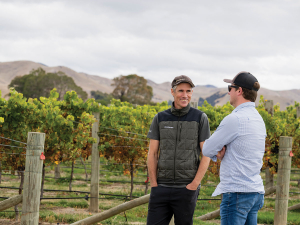Integrape Pro: NZ Vineyard Data Gets Granular
After more than 20 years collecting and curating data for winegrowers, a homegrown software company is taking its vineyard views to a new level.
 Integrape’s Joris Besamusca with Jarrah Prior, General Manager Winegrowing at Saint Clair Family Estate. Photo by Wara Bullôt, Plant & Food Research,
Integrape’s Joris Besamusca with Jarrah Prior, General Manager Winegrowing at Saint Clair Family Estate. Photo by Wara Bullôt, Plant & Food Research,
In an industry where succession stories are an enduring tradition, the Besamusca family has tapped into intergenerational talent to offer layered and accessible data to vineyard operations.
Integrape was seeded in 2002, when viticulture consultant Gerard Besamusca sought a systemised approach to the wealth of information required to serve his clients. His son Joris, now Managing Director of Integrape, notes that 20 years ago data was paper or file based, with reports stored as PDFs in emails or in filing cabinets. “A major difference over the last 15 to 20 years has been a move to more connected data, with growers having data streams from machinery, more infield sensors, staff chat apps and a range of cloud-based services.”
Gerard’s daughter Mirjam, who had worked five years with Hill Laboratories’ software team, helped develop the tool, and as he tapped into the data and associated graphs, the consultant found clients eager to access their data in the same way. He called on Joris, then a freelance web developer, to provide a cloud-based interface, which was launched as Integrape in 2004. “With a background in design, my approach to the problem focused on the importance of making the information easy to navigate and digest,” Joris says. “A key aspect of this visualisation was the spatial variability of a vineyard, with results presented on interactive maps – pixel-based representations – before services like Google Maps existed.” His mother Mieke was also involved in setting up hundreds of vineyard block maps and result allocation in the early days of Integrape.
In 2016 Joris led a major rebuild of the system, including a shift to a “true” geographical information system, enabling incorporation of layers such as remote sensing through drone and satellite imagery. He then formed a new company to separate the software from Gerard’s business, with a focus on bridging the gap between data and its presentation. These days Integrape and its offshoot Vure, a data collection app, are used on around a third of New Zealand’s planted vineyard area, covering more than 300 vineyards from Northland to Central Otago, and in trials in France, California and Australia.
Joris says that while data has increased exponentially in volume, resolution and frequency, it often remains siloed. “A lack of interoperability between platforms and formats can lead to reactive management, with important information often being too difficult to include in relevant decisions.” Integrape’s point of difference is that it doesn’t focus on one particular type or source of data, he says. “For example, remote sensing offers a great way to capture full vineyard variability using vegetation indexes, but to test the soil, samples still need to be analysed in a laboratory. Meanwhile cameras travelling through rows are an exciting new option for assessing certain metrics – but bunches still need to be weighed and counted manually for accurate results. The aim is to provide a platform where all this data can be integrated into the decision process.”
The continued success of Integrape lies in ongoing conversations with viticulturists and growers, “to better understand how our software might help them collect, organise and dissect the information they need”, Joris says. “One exciting recent development has been the availability of yield maps produced by some of the newer harvesters. On their own they provide a nice overview, but we are now trialling the integration of this data to help calculate optimised sampling locations for yield estimation.”
Integrape is one of the companies at WinePro this June. “Often these discussions also lead to ideas for improvements or even different applications that help us shape our product roadmap”, Joris says, explaining that on-the-ground industry involvement is a key part of the “Integrape equation”, along with scientific, data-based representation. “As such we’ve been working to develop close relationships with crown research institutes like Plant & Food Research, as well as the likes of Bragato Research Institute, to incorporate the work they produce into tools that are directly valuable to end industry users.”
He paraphrases his father in saying “the best way to really understand what’s happening in the vineyard is to walk amongst the vines”. But many growers are managing greater areas with less time, while the volume of analytical data has steadily increased, as has the emphasis on reporting. “The challenge is finding the balance between data driven decisions, and providing efficiencies that allow more time in the vineyard, backed with the macro and micro insights offered by technology.”

The end of the year is fast approaching, so here are some thoughts on a few of the significant developments…

OPINION: When I moved to Marlborough two decades ago, I found countless lines of tidy vines, neatly mowed and carefully…
The large 2025 harvest will exacerbate the wine industry's "lingering" supply from recent vintages, New Zealand Winegrowers Chief Executive Philip…
If you find a new consumer in a developed wine market, you are taking them from someone else, says Blank…
OPINION: Sauvignon Blanc was famously introduced to New Zealand by Ross Spence of Matua Valley, and then serendipitously planted in…